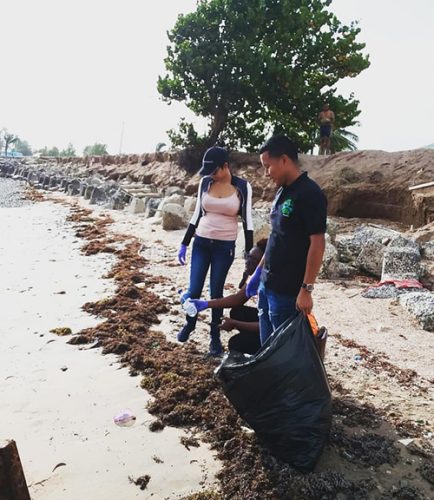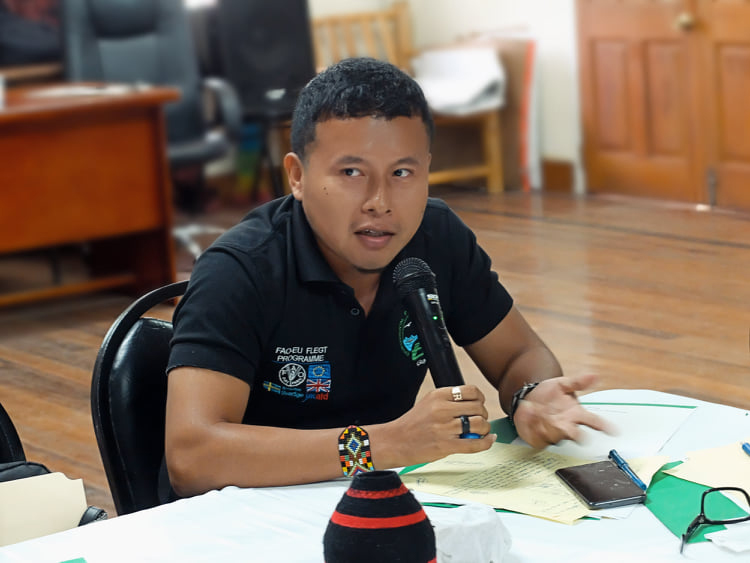He grew up swimming in the Cedak Creek, which he says was once so transparent that during fishing expeditions he could see the fish as it bit the bait on his fishing line.
“I guess you can say that I fell in love with rivers the first time I saw one,” Romario Hastings, 24, told Stabroek Weekend during an interview last week, before adding that while many changes have taken place in his life, his love for rivers has remained.
Hastings was born in the Indigenous community of Kako, Upper Mazaruni, to Akawaio parents. There, he lived a simple childhood. Like many other Indigenous children, he helped out at the farm and went on many fishing expeditions with the villagers.

As a child, he said, he never fully understood what was taking place in the community and, on a larger scale, the country. He knew that his region was blessed with precious minerals, such as gold and diamond but he never knew about the devastating impacts that mining them had on his beloved rivers.
That would soon change, however, as he would soon move to the city to continue his secondary education. He had ambitions about attending school at President’s College and even informed the then Minister of Education of his dream during a visit to the community. “When I was told that I was awarded a place at the college, I was so surprised that my dream had come true,” he said.
At the school, he went into the science stream and was planning to study medicine. As fate would have it, all his plans changed when he went back home after completing his secondary education and he saw first-hand what mining was doing to the rivers in and around his community. “Things changed for me because when I went home [Kako], I found that there were many environmental issues plaguing my village, from environment degradation and water pollution, all [of] which were stemming from one major activity, mining,” he disclosed.
He started attending village meetings and as time passed, the National Toshaos Council (NTC), where he learned that one of the main challenges facing Indigenous communities is the devastating impact of mining. That, he said, was an issue talked about at every NTC conference. “That is one of the main reasons that pushed me towards environmentalism,” he added before saying that after his visit to his home he decided to pursue a degree in Environmental Science at the University of Guyana.
In addition to working on being an environmentalist, Hasting says that he is also passionate about his culture. “I believe that environment and Indigenous culture come hand-in-hand. They are so connected that I don’t believe one can exist without the other,” he explains.
However, he admits that when he first travelled to Georgetown, he was insecure about his heritage was only through education and research that he started embracing his culture. “I realised what I have is something that should be preserved,” he says, while noting that the dying cultures of the Indigenous people, especially the languages, are also one of his main concerns now.
It is for these reasons that Hastings is interested in entering the political arena.
He says that he believes not enough is being done to address those situations. “I want to put a halt to all the lawlessness that goes on in Guyana in those regards. People don’t realise that fresh water will be one of the most precious resources that we are going to have soon. I feel a sense of connection with the environment and the people, maybe it’s because of where I grew up but I feel a responsibility toward the preservation of our culture and environment, which directly includes Indigenous culture because if nobody wants to do it who is going to do it? And I understand the importance of this and that’s why I feel the responsibility to preserve it,” he explains.
He also wants to be a voice for Indigenous People and to lead the way in changing how many Indigenous leaders represent their communities. “I have seen representation at the NTC and I am not satisfied with the representation from the majority of the toshaos. I am not satisfied with their demands from the government. Community development is not about a tractor or ATV or these material things that have a short life and we need leaders to think about the community in the next forty years and think about the youths and education and our health systems and how we can improve it and to think about ways where the culture can be enhanced and improved and establishing cultural institutions in our own districts. Things like that I wanna see within our representation. In addition, we should not be begging for things that are the responsibility of the government, like schools to be established or computer labs or teachers. That’s the obligation of the government and we need to be more forceful,” he says before adding that once given a chance, he will implement all that he has learned for the Indigenous peoples to have a better life.
Hastings, who now holds a Bachelor’s Degree in Environmental Science, currently works at the Environmental Protection Agency (EPA). However, he notes that this will not be the end of his journey as he will soon be continuing his education by pursuing a Master’s Degree.
Hastings notes that while working at the EPA he learned how complex one issue can be because there are so many parties involved in decision-making, like the Guyana Geology and Mines Commission and the Lands and Surveys Commission. He says once he completes his education, he will be better equipped to protect the environment, especially the rivers and his people.
Meanwhile, he divides his time between work and ensuring that he does whatever he can to protect the environment, like picking up garbage from the seawall and other places.






